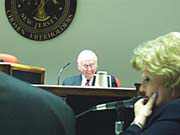Bayonne Freeholder Barry Dugan led the questioning at last week’s county freeholder meeting over the funding of welfare-to-work programs that he said did not show convincing results.
Welfare-to-work is a concept resulting from federal welfare reform initiatives designed to get people off the welfare roles and into jobs.
Dugan said annual money paid to firms to train and place people have done “a horrible job,” quoting one report that showed that of 355 individuals trained, 102 were placed into jobs, but only four still were employed in those jobs after 90 days.
Ben Lopez, director of welfare-to-work activities for the county, said federal initiatives implemented in the mid-1990s that provided limited training to welfare recipients merely skimmed the most skilled part of the population during the early years, leaving behind the most difficult-to-train part of the population
Since 1997, when the law first went into effect, the county programs have successfully reduced the welfare population from 22,000 cases to slightly over 5,000, according to county records.
“But these [5,000] are the most difficult to place,” Lopez told the Freeholders.
Many of these people will not respond to the limited training the federal law has provided, but need a year or more to bring up their skills to an employable level, he said.
While payment for vendors providing training can depend partly on job placement and retention, there are other factors that figure into payment, and most vendors are paid at stages of success leading to employment.
Under the existing program that Freeholder Bill O’Dea called “a revolving door of failure,” clients are brought in and trained on a cycle of weeks before pushed out to seek jobs. The job training courses included a variety of areas from office computer training and cable installation specialists to customer service.
Lopez, however, said the initial training during the early years of the program managed to place those people who were already prepared to work, but the fact that the existing programs provide weeks of training for welfare workers is not enough for those currently on the welfare rolls.
Lopez noted that the report in front of the freeholders was a little misleading because clients are placed according to available slots. Each training group is given a maximum number of job placement slots, which Lopez said each group fills. But he said the law mandating training and return to work of these clients does not pay for follow up maintenance.
Lopez said, however, that the state has stepped up to help solve the problem, and has set new rules for allowing more extensive job training programs for the most hard-to-train population.
How the system will change
Problems with the federal system of welfare to work existed because there was no incentive to actually get people jobs, according to adult education professionals.
Before the state of New Jersey stepped into solve the training problem, for-profit and non-profit organizations got paid per student for levels of achievement, one teacher said. That means a company doing business with the county will get some money for the number of students enrolled, more if these people reach a certain point in their lessons, still more when they graduate, and more if they are placed in a job and remain in the job 60 to 90 days.
Because many of the people who are left on the welfare rolls are the toughest cases to place, these agencies often over-enroll students, drawing grant money for the earlier stages knowing they will not get paid for placement or for maintaining jobs.
Many of the people who are being trained are called the “hidden homeless,” and often live with friends, family members or at homeless shelters. Many are even residents of drug treatment centers. Women with kids often find themselves choosing between school and home when daycare – often from family members – ceases.
Job placement is extremely difficult, particularly because of two issues: lack of driver’s license and criminal records.
“These are the hardest of the hardest to serve,” Lopez said.
Under the federal regulations, clients could not be evaluated for the needs, even if they had medical, psychological or social barriers keeping them from work. They got four weeks of training and then were required to seek work, and the county had to pay vendors whether or not the people got work. Conditions for placement, too, were difficult even in a good economy when there was little competition for jobs, but in a bad economy things get worse.
Under new guidelines set by the governor’s office, Lopez said there is more flexibility in helping get people skills and vocational training, and that his office will be able to put more individuals into career paths over a two-year period rather than the four- to 12-week training sessions initiated by federal regulations.
